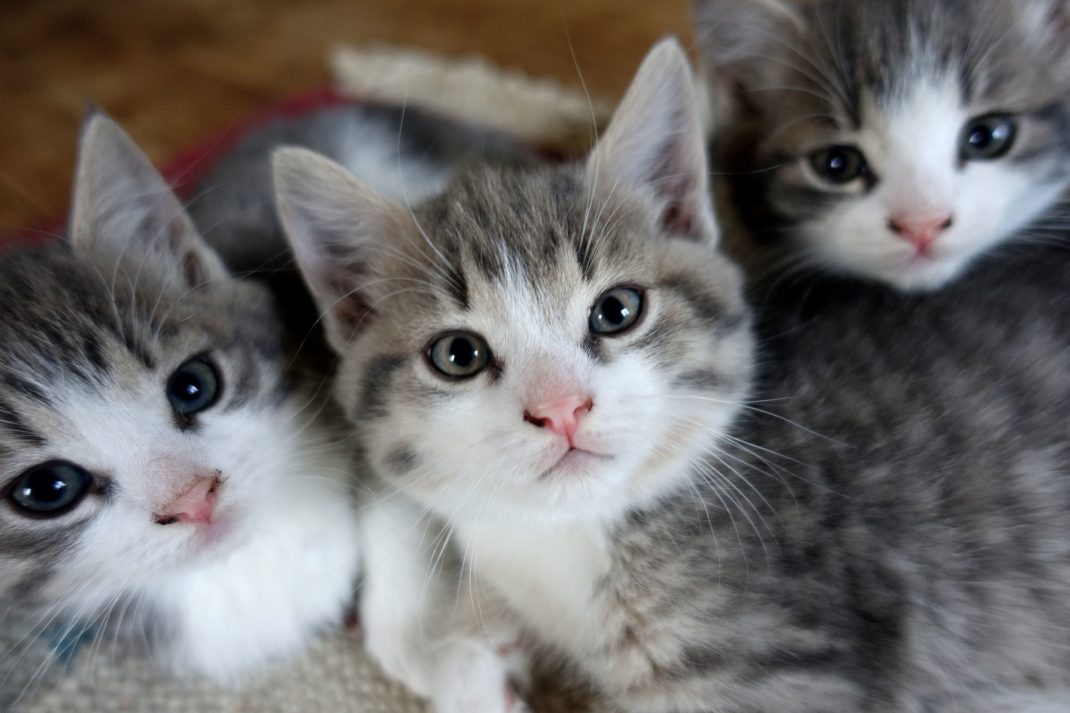How to housetrain kittens
We just got an adorable new litter here at home. Now it's time to housetrain kittens!

It's time to housetrain kittens here at home! Granat (Grenade), Missil (Missile) and Nisse are the cat Bomben's (The Bomb's) new kittens. So cute!
Look at these cuties! Three gray little balls of fur are running around the house like crazy. They are seven weeks old now and our kids absolutely adore them. This is our cutest litter so far! We plan on keeping one of them.
I know that a lot of you might wonder how to raise and housetrain your cats. So, I decided to write about how we do it here at home:
Litter box or not?
I simply hate the smell of cat pee (and poop too for that matter), both inside and outside. I don't think I could ever keep a litter box inside permanently, the smell is too awful. Our cats are outdoor cats and nature is their litter box.
We live in the countryside so the cats have a lot of room to roam. We have a large sandbox for the kids as well as the many garden beds of course, but we haven't had any issues at all with cat feces in the wrong places.
We do keep a litter box inside, but we only use it when there are kittens in the house or if one of our cats is sick. I really don't like it. We keep it in the bathroom, where the cats also eat. There's a cat flap in the bathroom door so that the cats can have a little space to themselves in there.
The first few weeks
The first few weeks with kittens are very relaxed. The cat nurses her kittens, and she cleans up after them too. They start eating regular food at around 4 weeks old, which is when the real work begins. We keep their food (wet and dry) and water next to a large tray filled with cat sand. The food and the sand are located right next to where the kittens rest, and we try to lift them to the sand as often as we can. They learn quickly, even though their mother goes outside when nature calls. The litter box doesn't really smell at all when the kittens are still small. This is a big plus when you start to housetrain kittens.
We started by keeping this year's litter in the kitchen, but then we moved them (together with their food and litter box) to the hallway after a few weeks. We keep the main door open until late at night in summer. The kittens are actually really good at doing what they need to do in the litter box, our outside while playing. They get a lot of praise when they do it outside.
But sometimes, they don't make it to the litter box when they play inside. There's always something to clean up here and there when you start to housetrain kittens. Especially if they have been exploring other parts of the house. This is just something that we need to live with. The kitten pee doesn't really smell at all, compared to grown cats.
Take the box outside
One of the most important things to think about when you want to housetrain kittens is to make them associate the box with going to the bathroom. When they get the hang of this, we move the litter box outside during daytime, and then I carry it back inside at night. I'm going to put the litter box right by the cat flap in a few weeks. When they see the big cats using the cat flap and learn to do the same, I will put a symbolic little box next to the flap on the outside too. They don't use it very often though, they do what they need to do outside now.
What if it's raining or wet outside? Well, then we need to put some kind of roof over the litter box.
When I housetrain kittens, I always do it step by step. It's been working really well so far and I won't have to worry about the smell or having my kids mess around in the litter box either.
The process takes a few weeks, but it's so worth it. I want them to be outdoor cats and this is a great way to teach them how from the start.
More about our pets: My Newfoundland dog Captain Kuling
Our cats
I know that a lot of people live in cities and keep their cats indoors. I just want to finish by telling you a bit about what it's like to have outdoor cats in the country side.
All of our cats are outdoor cats. They are regular farm cats, some of them born in this house many years ago, and others came to us as kittens. I have previously adopted cats from shelters but it just hasn't been working very well. The cats have been scared and hard to keep around the house. The kittens we finally decided to go for have all grown up in environments similar to this one. It's been great!
Our cats go very well together and they accept each other, even though the older cats want to stay outside more when we have kittens in the house. We have a large dog too, but that has never been a problem. They learn to live together. I just love watching the kittens sneak up on our huge Newfoundland dog when he's sleeping. So cute!
Read more about our pets: Getting a Newfoundland dog
The cats love sleeping inside in our armchairs and sofas, but they don't have access to the top floor where we have our bedrooms. Outdoor cats love to roll around in the dirt and I'm afraid that they will start to bring in ticks. There are these horrible little insects called thrips that often get stuck in the fur too. Thrips bite and I really don't want to get them into my kid's beds.
Our cats live most of their lives outdoors. They just love being lazy in the shade outside, but the polytunnel is a great spot too. They also enjoy climbing trees, running around the field, playing with the kids and joining us for walks. And they hunt! A lot. Mice, voles, moles, birds, bats, hares and insects. I'm especially happy that they get rid of the mice in the garden. The kitten's mother Bomben (the bomb in English) has already brought a few of them inside to teach the kittens how to hunt.
About outdoor cats
Outdoor cats are just as loved as indoor cats. They are just as missed as the indoor cats when they pass away. Their personalities are just as diverse as us humans, and they can truly be eccentric. One of my cats called Bacill tried to sing along whenever I started playing my guitar. Bandit used to scratch the window when he wanted to come inside and Monster always joined me when I was working in the garden.
We have had indoor cats too in the past, but I just don't think that they get to have a full life this way. This is my experience and opinion of course, and I completely understand other points of view too. For me, it's hard to keep a cat inside when I see how much they enjoy being outdoors. This point of view also means that I need to accept the dangers of this lifestyle of course. But I think that a life in freedom outside, paired with the risks of predators and snakes, is better than being shut inside.
One of the hardest things is to accept that they do pass away. We, unfortunately, lost two cats last year, Monster was one of them. I have so many fond memories of him. I held him and rubbed him when he had just been born since his mother was too worn out to start licking him. He's the only cat my husband actually had to take to the vet to euthanize. But this is a necessary part of life when you own a pet. Our cats are all fixed (after the female got these kittens) but they aren't insured or vaccinated. If the cat is too sick or hurt, we have to put it down. We bury our cat friend underneath the apple tree, sing the national anthem and talk about old memories. Then, we get another cat.
Most of the farm cats where I live have this kind of lifestyle. What's your experience?
These are just a few of my cat-related thoughts, I hope they gave you some tips on how to housetrain kittens. Keeping the litter box in the same area as they eat and then putting the box right outside the door. That's basically the gist of it. Do you have any other tips on how to housetrain kittens?
/Sara Bäckmo
09. July 2018



Leave a Reply